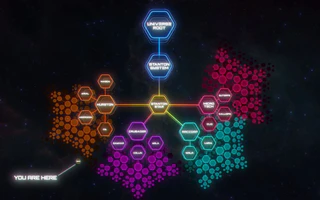
Server meshing is a technology that allows several servers to connect together and to work seamlessly as if they were a single large server.
A single server has a limited maximum physical capacity of what it can handle. Usually, MMOs are limited by their technology and infrastucture in how many players a server can handle simultaneously, which results in a maximum number of players in the same gamespace. Going above the maximum limit creates a number of performance issues.
The aim of Cloud Imperium Games is to surpass those limits by using interconnected servers, without the players being able to notice it via loading times or the inability to interact between two servers, with the player being seemingly just on a single server as far as they are aware. Each server gets assigned to an area, or zone: one server can be assigned to a planet, while another gets assigned to a city on the planet, while another gets assigned to a spaceship in orbit, depending on the needs, on the number of players in each place.[1] For example, players can shoot each other across different servers, without even knowing that they are each on different servers.
This allows to have more people in the same universe overall, which allows to meet more people in game, which allows to have more interactions and gameplay experiences, participate in larger events with more people, and most importantly for the player to really feel that they are playing an MMO with a lot of people.[1] It also allows for more cohesiveness, for examle the economy being universe-wide rather than server-wide.[2]
Cloud Imperium Games considers this technology as the key to its ambition of a large shared massively multiplayer universe where thousands of players can interact in real time seamlessly without any interuptions or loading times.
Dynamic server meshing
Whereas static server meshing means that servers are pre-allocated and cannot be changed, dynamic server meshing means that servers can be dynamically moved as needed to respond to the needs. For example, if a single server was to only be able to handle 100 players, static server meshing would be insufficient if more than 100 people were in a single static server area, but with dynamic server meshing if 200 people, or 2000 people were in the same area, this area would get seamlessly subdivided between as many servers as needed when needed.[1]
This technology is expected to have a profound impact on the MMO games industry.
At the end of March 2024, a server meshing test allowed for 800 players to play together.
Meshing Test "E" was conducted on Star Citizen Birthday on Oct 10th 2024, to measure the behaviour of the Hybrid at a 1000 player concurrency, and was pushed further to 2000 concurrent players cap to measure stability and shake-out new crashes.[3]
Server meshing went fully live in December 2024 with the preview of alpha 4.0 with 500 players per shard.
Other games
While server meshing itself in various forms isn't new, its application under a dynamic form to an MMO of the scale of Star Citizen has not been done before.
Ultima Online from Origin Systems where Chris Roberts worked, had technology similar to server meshing where a player couldn't see beyond a line, but was able to cross it and then see what was on the other side.
Server meshing proper has been used in various forms under varrying implementations, with Spatial OS and games such as Atlas, Dual Universe, Scavengers or Dune Awakening. Ashes of Creation is also working on server meshing.[4]
However this would usually work by using a transitional space such as a corridor or an elevator, or by using continents separated by water, and by being static rather than dynamic.
Having dynamic server meshing on Star Citizen's scale is entirely new, among others because cloud computing at a commercial scale itself is relatively new.
Criticisms
Dynamic Server Meshing, as envisionned by CIG, has been called technically impossible, and unnecessary even if possible. It has been considered as a costly and lenghty Research & Development that isn't worth the time or the money for most gaming studios.
See also
External Links
References
- ↑ Jump up to: 1.0 1.1 1.2 Le serveur meshing en 180 secondes, par Benoit Beausejour, Star Citizen Francophone, YouTube, 24 nov. 2023
- ↑ Server Meshing and Persistent Streaming Q&A. Transmission - Comm-Link
- ↑ Server Meshing Test "E" After Action Report. Spectrum. Retrieved 2024-10-13
- ↑ "Our next Development Livestream featuring an Alpha Two Server Meshing Technology Preview is coming to you LIVE on Friday, June 28, 2024", @AshesOfCreation, Twitter, Jun 21, 2024